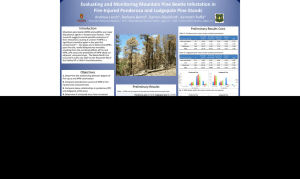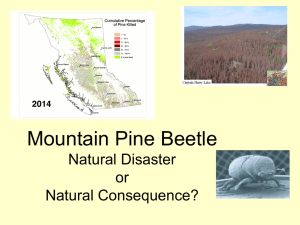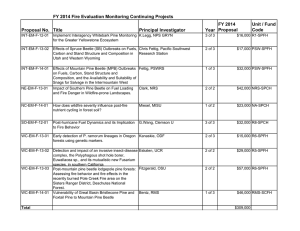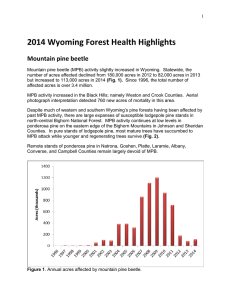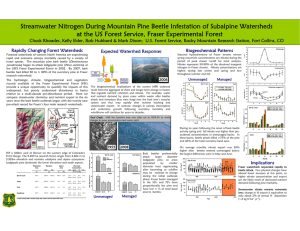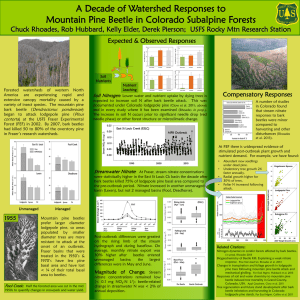Genetic Variation of Lodgepole Pine Physical and
advertisement
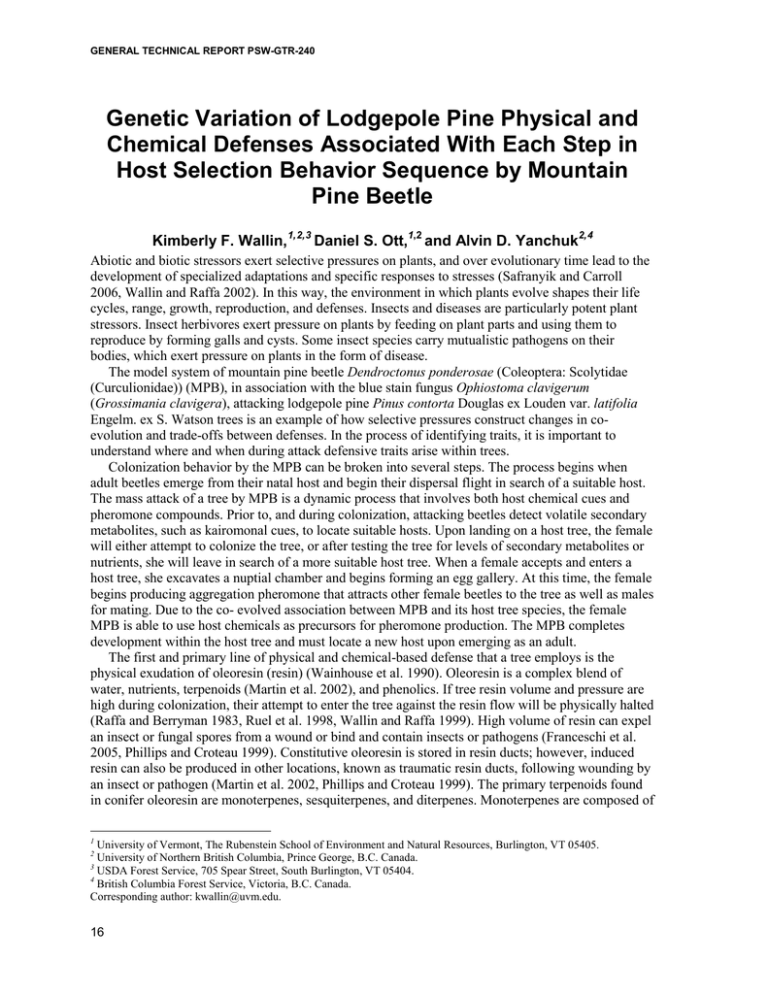
GENERAL TECHNICAL REPORT PSW-GTR-240 Genetic Variation of Lodgepole Pine Physical and Chemical Defenses Associated With Each Step in Host Selection Behavior Sequence by Mountain Pine Beetle Kimberly F. Wallin, 1,2,3 Daniel S. Ott,1,2 and Alvin D. Yanchuk2,4 Abiotic and biotic stressors exert selective pressures on plants, and over evolutionary time lead to the development of specialized adaptations and specific responses to stresses (Safranyik and Carroll 2006, Wallin and Raffa 2002). In this way, the environment in which plants evolve shapes their life cycles, range, growth, reproduction, and defenses. Insects and diseases are particularly potent plant stressors. Insect herbivores exert pressure on plants by feeding on plant parts and using them to reproduce by forming galls and cysts. Some insect species carry mutualistic pathogens on their bodies, which exert pressure on plants in the form of disease. The model system of mountain pine beetle Dendroctonus ponderosae (Coleoptera: Scolytidae (Curculionidae)) (MPB), in association with the blue stain fungus Ophiostoma clavigerum (Grossimania clavigera), attacking lodgepole pine Pinus contorta Douglas ex Louden var. latifolia Engelm. ex S. Watson trees is an example of how selective pressures construct changes in coevolution and trade-offs between defenses. In the process of identifying traits, it is important to understand where and when during attack defensive traits arise within trees. Colonization behavior by the MPB can be broken into several steps. The process begins when adult beetles emerge from their natal host and begin their dispersal flight in search of a suitable host. The mass attack of a tree by MPB is a dynamic process that involves both host chemical cues and pheromone compounds. Prior to, and during colonization, attacking beetles detect volatile secondary metabolites, such as kairomonal cues, to locate suitable hosts. Upon landing on a host tree, the female will either attempt to colonize the tree, or after testing the tree for levels of secondary metabolites or nutrients, she will leave in search of a more suitable host tree. When a female accepts and enters a host tree, she excavates a nuptial chamber and begins forming an egg gallery. At this time, the female begins producing aggregation pheromone that attracts other female beetles to the tree as well as males for mating. Due to the co- evolved association between MPB and its host tree species, the female MPB is able to use host chemicals as precursors for pheromone production. The MPB completes development within the host tree and must locate a new host upon emerging as an adult. The first and primary line of physical and chemical-based defense that a tree employs is the physical exudation of oleoresin (resin) (Wainhouse et al. 1990). Oleoresin is a complex blend of water, nutrients, terpenoids (Martin et al. 2002), and phenolics. If tree resin volume and pressure are high during colonization, their attempt to enter the tree against the resin flow will be physically halted (Raffa and Berryman 1983, Ruel et al. 1998, Wallin and Raffa 1999). High volume of resin can expel an insect or fungal spores from a wound or bind and contain insects or pathogens (Franceschi et al. 2005, Phillips and Croteau 1999). Constitutive oleoresin is stored in resin ducts; however, induced resin can also be produced in other locations, known as traumatic resin ducts, following wounding by an insect or pathogen (Martin et al. 2002, Phillips and Croteau 1999). The primary terpenoids found in conifer oleoresin are monoterpenes, sesquiterpenes, and diterpenes. Monoterpenes are composed of 1 University of Vermont, The Rubenstein School of Environment and Natural Resources, Burlington, VT 05405. University of Northern British Columbia, Prince George, B.C. Canada. 3 USDA Forest Service, 705 Spear Street, South Burlington, VT 05404. 4 British Columbia Forest Service, Victoria, B.C. Canada. Corresponding author: kwallin@uvm.edu. 2 16 Proceedings of the 4th International Workshop on Genetics of Host-Parasite Interactions in Forestry two isoprene units; sesquiterpenes are composed of three isoprene units; and di-terpenes are composed of four isoprene units. Various side groups can/may be present, and terpenoids are often oxygenated. Terpenoids constitute a major class of secondary metabolites in conifer oleoresin; they play an important role in the relationship between conifers, insects, and pathogens. They may deter insect feeding or affect fungal growth; be induced to change in abundance in response to wounding; be precursors for pheromone components used in insect communication; and affect insect and fungal reproductive success. Raffa and Berryman (1987) found induced monoterpenes to be a major factor in tree resistance to mountain pine beetle colonization. The type and quantity of compounds in the oleoresin of plants influence herbivory (Zangerl and Berenbaum 2004). These same compounds or a combination thereof also affect pathogens that attack plant systems. Herbivores may be deterred or killed because of an inability to overcome these resin toxins or physical defenses (Raffa and Berryman 1983). Pathogens may be compartmentalized and contained within the tree, unable to spread. The mode of toxicity of a particular resin secondary metabolite to an invading pest varies. Some terpenoids interfere with insect digestion, while others affect insect reproduction, decreasing fecundity or future fitness. Secondary metabolites may also interfere with disease processes; for instance, some terpenoids inhibit germination of spores or growth of fungi (Klepzig et al. 1996, Six and Klepzig 2004). The third line of defense for lodgepole pine is through its secondary metabolites, including terpenoids (Franceschi et al. 2005). Constitutive terpenoids may be enough to overwhelm attacking beetles. If the constitutive defenses are not successful, induced terpenoids are produced and may stop the bark beetle and its associated fungi. These tree chemicals can be very toxic to the mountain pine beetle (Klepzig et al. 1996, Raffa and Smalley 1995, Reid and Robb 1999). Quantifying the relationships between concentrations of host compounds at the early phase of host colonization is an important step toward understanding how variability of host responses impacts the success of MPB attacks. This information will be used to improve indices of tree resistance and relate specific host properties to survival of MPB outbreaks. Studies have already demonstrated that the composition and/or concentration of monoterpenes in either constitutive or induced tissue can be linked to the likelihood of host mortality to subcortical complexes (Nebeker et al. 1992, Raffa and Berryman 1982). While resin flow and tree chemistry affect MPB progression throughout its life cycle in the tree, a tree also responds to the fungi by allocating carbon-based defenses to the site in an attempt to stop the growth of the fungi (Krokene et al. 2000). The tree defense strategy against blue stain fungus is apparent as a dark, resinous lesion on the phloem and xylem (Raffa and Berryman 1983, Wallin and Raffa 2001), which may compartmentalize and stop fungal growth. When this occurs, the tree successfully halts the colonization attempt by the individual beetle or pair of beetles and their associated fungi. The goal of this research was to quantify responses during outbreak using replicated study plots of 20-year-old lodgepole pine, which provided the opportunity to calculate heritabilities and correlate MPB behaviors and tree responses during colonization sequence. The trees used in this research were open pollinated, so the mother of each tree and her provenance are clearly known. Known pedigree of progeny will allow the comparison of defense-related phenotypical differences across a broad range of lodgepole pine families. An understanding of the heritability of defenses in lodgepole pines will provide guidance to tree breeders as they seek to develop more resistant strains of pines for planting future forests. The current outbreak of MPB has killed about 15 million ha of lodgepole pine in British Columbia. This is of great concern to the entire forestry industry and provided a framework to study genetic variation of lodgepole pine defense mechanisms against MPB. Based on a previous study, we selected 45 open-pollinated families from a population of 180 families, with the number of trees per family ranging from 16 to 26 (for a total of 887 trees) across two sites. During the summer of 2006, we quantified chemical and physical defensive responses to simulated attack by the MPB fungal complex. These responses included: physical exudation of resin, host compartmentalization response 17 GENERAL TECHNICAL REPORT PSW-GTR-240 to fungal inoculation, and constitutive and induced terpenoids. During the summer and fall of 2007, we further assessed tree height, DBH (diameter at breast height, about 1.4 m), bark texture, tree mortality; and MPB presence, attack density, reproduction, and brood development, as well as the presence of hypersensitivity reactions by the tree to MPB. Our data suggests variation in terpenoid makeup pre- and post- induction of simulated MPB attack is significantly different between families. Traits in lodgepole pine that affect MPB colonization and tree mortality also vary among families. Estimates show many host tree traits that affect the MPB life cycle are significantly heritable. We calculated family mean correlations of traits with significant heritabilities. Results suggest that several specific lodgepole pine tree defenses are heritable. Some constitutive (pre- induction) terpenes were negatively correlated with family mean mortality. The frequencies of induced reactions were negatively correlated with MPB gallery production, reproduction, and brood development. These results may provide future direction for management groups trying to manage MPB outbreaks in lodgepole pine stands. Acknowledgments This work was funded by a British Columbia Forest Service grant to K. F. Wallin and A. D. Yanchuk, with support from Oregon State University, the University of Vermont, and the USDA Forest Service to K. F. Wallin. The authors thank laboratory and field crews for their assistance. Literature Cited Franceschi, V.R.; Krokene, P.; Christiansen, E.; Krekling, T. 2005. Anatomical and chemical defenses of conifer bark against bark beetles and other pests. New Phytologist. 167: 353–376. Klepzig, K.D.; Smalley, E.B.; Raffa, K.F. 1996. Combined chemical defenses against an insectfungal complex. Journal of Chemical Ecology. 22: 1367–1388. Krokene, P.; Solheim, H.; Langstrom, B. 2000. Fungal infection and mechanical wounding induce disease resistance in Scots pine. European Journal of Plant Pathology. 106: 537–541. Martin, D.; Tholl, D.; Gershenzon, J.; Bohlmann, J. 2002. Methyl jasmonate induces traumatic resin ducts, terpenoid resin biosynthesis, and terpenoid accumulation in developing xylem of Norway spruce stems. Plant Physiology. 129: 1003–1018. Nebeker, T.E.; Hodges, J.D.; Blanche, C.A.; Honea, C.R.; Tisdale, R.A. 1992. Variation in the constitutive defensive system in loblolly pine in relation to bark beetle attack. Forest Science. 38: 457–466. Phillips, M.A.; Croteau, R.B. 1999. Resin-based defenses in conifers. Trends in Plant Science. 4: 184–190. Raffa, K.F.; Berryman, A.A. 1982. Physiological differences between lodgepole pines resistant and susceptible to the mountain pine beetle and associated microorganisms. Environmental Entomology. 11: 486–492. Raffa, K.F.; Berryman, A.A. 1983. The role of host plant resistance in the colonization behavior and ecology of bark beetles (Coleoptera: Scolytidae). Ecological Monographs. 53: 27–49. Raffa, K.F.; Berryman, A.A. 1987. Interacting selective pressures in conifer-bark beetle systems: A basis for reciprocal adaptations? American Naturalist. 129: 234–262. Raffa, K.F.; Smalley, E.B. 1995. Interaction of pre-attack and induced monoterpene concentrations in host conifer defense against bark beetle-fungal complexes. Oecologia. 102: 285–295. Reid, M.L.; Robb, T. 1999. Death of vigorous trees benefits bark beetles. Oecologia. 120: 555–562. Ruel, J.J.; Ayres, M.P.; Lorio, P.L. Jr. 1998. Loblolly pine responds to mechanical wounding with increased resin flow. Canadian Journal of Forest Resources. 28: 596–602. 18 Proceedings of the 4th International Workshop on Genetics of Host-Parasite Interactions in Forestry Safranyik, L. and Carroll, A. L. 2006. The biology and epidemiology of the mountain pine beetle in lodgepole pine forests. Natural Resources of. Canada.1-66. Six, D.L.; Klepzig, K.D. 2004. Dendroctonus bark beetles as model systems for studies on symbiosis. Symbiosis. 37: 1–26. Wainhouse, D.; Cross, D.J.; Howell, R.S. 1990. The role of lignin as a defense against the spruce bark beetle Dendroctonus micans: effect on larvae and adults. Oecologia. 85: 257–265. Wallin, K.F.; Raffa, K F. 1999. Altered constitutive and inducible phloem monoterpenes following natural defoliation of jack pine: implications to host mediated interguild interactions and plant defense theories. Journal of Chemical Ecology. 25: 861–880. Wallin, K.F.; Raffa, K.F. 2001. Effects of folivory on subcortical plant defenses: Can defense theories predict interguild processes? Ecology. 82: 1387–1400. Wallin, K.F.; Raffa, K.F. 2002. Density-mediated responses of bark beetles to host allelochemicals: a link between individual behaviour and population dynamics. Ecological Entomology. 27: 484– 492. Zangerl, A.R.; Berenbaum, M.R. 2004. Genetic variation in primary metabolites of Pastinaca sativa; Can herbivores act as selective agents? Journal of Chemical Ecology. 30: 1985–2002. 19

